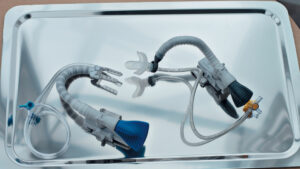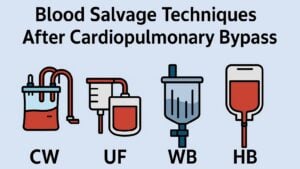Bob Groom: Welcome back. It’s great to see you back from break. We’re going to move into this next session. Our topic for this session is manpower challenges, burnout, and post-traumatic stress disorder (PTSD). These, I think, are some of the occupational hazards in our field that we deal with a lot, but we don’t often talk about them at scientific meetings. We’re very fortunate today to have a world-class panel coming to speak to us about these three subjects and to dig a little deeper on it.
Embedded in these presentations are audience response system (ARS) questions. We will be polling you and you can respond to the poll through the app. You go to the app, there’s a button there that has a question mark on it, and that’s audience response to ARS. When the polls come up during these presentations and when the polls come up during the discussion, please respond using the app.
The other thing I would mention is that we’ve received a grant and we’re going to be able to publish the proceedings of this session in the journal. We feel like this is such an important topic, and we’re so fortunate to have these experts today to speak to these three subjects that will be published in the journal along with all of the questions and comments and polling results. With that, I’ll invite Scott up to invite our first speaker to the podium.
Scott Snider: Our first presenter is Bradley Kulat. Bradley has been in the field for 28 years. He has also served as a pediatric clinical instructor and a student educator in Chicago, but a lot of us know him as the secretary for the American Board, our certifying agency. He’s also very active in the Accreditation Committee Perfusion Education (AC-PE) and [KHEP 00:02:20]. Bradley has given several presentations on clinical studies, but today he will be presenting on the results of a survey that was recently conducted by the American Board.
Bradley Kulat: Good morning everyone. On behalf of the American Board, I’d like to thank AmSECT for inviting me to speak today. Thank you for the nice introduction and invitation. I really appreciate being here.
So, let’s dive into the survey. Why did the American Board sponsor a survey of workforce practices? Well, basically it came from requests from the perfusion organizations, from our perfusion educators, some of those who are sitting right in front of me, and from individual perfusionists to understand the direction of the current workforce. Another major driver behind this survey is that there’s really no valid survey of staffing and retirement rates for certified clinical perfusionists.
The American Board, as the credentialing source for perfusionists, would be the most consistent and valid source to capture and survey the workplace environments of the Certified Clinical Perfusionists (CCP). The board of directors took this to heart and decided that the American Board would like to support this survey and help facilitate a workforce survey to help all the CCPs in practice.
In 2016, the American Board developed and sponsored 12 survey questions. We purposefully kept the number of questions low. We didn’t want to have a large amount of questions and have people burned out on the questions or skip over questions. Our intent was to limit it to less than 15 questions. Filing the survey questions by the CCPs was actually tied in to the recertification process. When you hit “send” in your recertification process, you automatically were redirected to the Survey Monkey within 3 seconds. In Survey Monkey, you were actually de-identified. We do not have Russian spies on the American Board, so nobody knows who you are.
For the 2016 survey, 3,056 of 3,875 eligible CCPs responded to the survey. That’s a 78.9% response rate. Survey questions covered demographics, education levels, years of clinical experience, recertification requirement satisfaction, and professional activity requirement contentment. Results were published in JECT. We’ll discuss this later in my talk.
For the 2017 recertification process, the AC-PE collaborated with the American Board to come up with survey questions. Linda, can you wave your hand out there? Linda is the president at the AC-PE, and she was a great help in driving this, so thank you, Linda. The American Board looked the survey questions over for redundancy and cleaned up the questions a little bit, but we left the autonomy for the AC-PE questions as is.
The 2017 survey mainly focuses on perfusion demographics and staffing issues within the respondents’ OR and also with the respondents’ extracorporeal membrane oxygenation (ECMO) and ventricular assist device (VAD) staffing situations. We also touched on some workplace practices and retirement rates. The CCP response rate to this survey was even a little bit higher at 83%.
Let’s dive back into the survey results, and you’ll see a lot of similarities from what Dave presented a little while ago to some of our results that we found. Again, we’re a male-dominated profession: 64% of CCPs are male. Age ranges, as Dave said too, are pretty consistent. The biggest cohort, 29%, range from 50 to 59 years old. We do have eight CCPs who are older than 70. Any of them here today? Well, congratulations because that’s amazing.
Years of being a CCP: 27.5% are greater than 25 years as a CCP. It’s interesting to note that the next cohort is 16.6%, which is the 1–5 years, so maybe we’re getting a little bump in the recent new grads. Years of experience by gender: also male dominated, 21% compared with 6.3% females at 25 years of experience. However, it’s nice to see a parity in the lower years of experience between males and females. This would be interesting to study in the future to see if there are more admissions of females into schools or more female applicants into perfusion schools. This is something that we can touch on in the future.
Highest level of education. Joe, you said a minute ago to that we’re all switching to master’s degrees. So, we will see the level of master’s compared with bachelor’s degrees become reversed in the next few years where then the minority of CCPs are predicted to be at a bachelor’s entry level.
Let’s look at the countries where the CCPs are located. Obviously, mostly the United States followed by our friends to the north, the Canadians. And then Rob Baker, you and your group over in Australia and New Zealand. We do have to my surprise four Greek perfusionists. I was talking to Christos yesterday; he knows them all by heart. It’s encouraging to see that CCPs are worldwide.
And by state, obviously we follow major populations and the majority of CCPs are in the state where we are sitting (California). Similar CCP population trends are found in Canada also. The majority of Canadian CCPs are in the Province of Ontario, Canada’s most populous province. In the United States, it is interesting to note there is one CCP who calls Wyoming home, and if you’re looking for a partner, I’d like to come join you. What a beautiful state that is!
As far as CCPs’ working community hospitals compared with academic health centers, Dave touched on this earlier that we’re kind of equally split between the community hospitals and academic health centers. Small contract perfusion groups, with fewer than 25 CCPs on staff, outweigh large contract groups by a small percentage. Anticipated range on bypass procedures also lines up with Dave’s findings that the majorities are split between 81–100 procedures and 101–120 procedures per year.
Let’s look at how our cases are staffed. Fifty-one percent of us are the only perfusionists doing a case, where 30% of us have two perfusionists and one backup in-house. This is a select “all that apply” question, so it might be a little diluted. I think we could’ve asked this question a little bit better and maybe we will revisit this question in the future. Staffing is even worse for emergency cases; a lot of us are being stuck at night alone. Sixty-five percent of us are the only perfusionists available and only 14% have a backup in-house.
These findings are not in line with the standards of AmSECT. Maybe some follow-up can be done on this from AmSECT? I congratulate AmSECT on their standards and guidelines. Actually, this standard helped me out recently to hire another perfusionist. It really woke our administration up that we were behind the current standard of clinical practice. It really helped me and my staff a lot and I appreciate AmSECT’s work on this.
ECMO shifts: who covers your ECMO shifts? Well, I’m glad to see that seventy-one percent of CCPs cover ECMO shifts. Again, this is a “select all that applies” question, and I think we could have defined this a little bit better, defining it to who initiates, who maintains, or who troubleshoots or comes off. That’s another opportunity in the future to look deeper into this question. Similarly, it’s almost the same with mechanical support. Almost 60% of CCPs are controlling all the mechanical support, so that’s great news for us.
How do we get paid? Well, the vast majority of us are salaried employees, and the average number of hours of work is 40 hours per week. This matches up with being paid a salary where you try to get to the exact number of 40 hours a week. To me, this was very surprising that it was almost exactly 40 hours. It seems like we all work a lot more than 40 hours a week!
Also, the average number of workdays per week is a little bit over 5 days a week, and also number of days on call per month was 13 days. Almost a half a month you’re on call! This is significant if you ask me. I think about our practice’s experience, and yes, it is about 13 days out of the month we are on call. Maybe Dr. Kraft will speak to us later on this issue because being on call is stressful. I know I’m on call this weekend, and I’m already stressing out about it. It’s not relaxing: it limits your lifestyle; it’s a burden on you and your family; and it adds to stress.
Actual time spent doing mainly clinical activities. This question could have been asked better. In the future, it would be better to divide this to determine if you’re a coordinator or supervisor or staff and then we can analyze the data a little bit more. So, the big question in the room is, “when are you retiring?” When are you hanging up the clamps? I’ve got to warn you that there are limitations to this survey. The American Board survey can only analyze CCP attrition rates. Actual retirement dates may vary because of factors such as the economy or personal decision. For example, I am due to retire in 8 years. My youngest daughter is 10 years away from graduating from college, so my wife has different plans for me.
The American Board cannot estimate or predict complex employee market demands or shortages. I was watching the Michael Colligan lecture video from the Sanibel conference, and it seems like supply and demand is kind of a problematic issue right now. There is really no true correlation yet that’s been determined between CCP supply and demand. So, other metrics in combination with the American Board workforce study will be needed to study CCP employment supply and demand.
Okay, let’s look at retirement. Basically, there are some of the similar things we saw earlier. Thirty-eight percent of CCPs are going to be retiring within 1–10 years. We followed it up with the AC-PE survey the following year and we got similar numbers, 39%, so this pretty much confirms what we were thinking. The main reason for losing your CCP is basically retirement.
Everybody gets this every year. It’s in the annual report. It shows the certification and recertification trends. The main thing is if you look at the top line here, how many new certifications were admitted to the CCP process? What were the total certified and lost certifications, people who gave up their CCPs because of retirement or other reasons? Since the year 2000, there has been a 25% increase in CCPs. And over the last 10 years, we’ve seen an average growth of about 1.65% of CCPs. This averages out to 50–60 new CCPs coming into clinical practice as a net gain. However, you can see that 3 years ago we kind of took a slight downturn in CCPs, so this is really going to have to be closely monitored.
In conclusion, our two surveys showed 38.2% retirement within the next 10 years. The 2017 survey was pretty similar at 38%. We do have an aging workforce. Twenty-nine percent of us are 50–59 years old, and 15.3% of us are 60 years or older. As I mentioned, there is a positive rate CCP workforce growth, but it is going to have to be closely monitored in the future to determine which direction we’re going. Perfusion employment supply and demand is a very complex issue and additional metrics are needed. I would urge caution on a personal level to look at the left side of this screen and draw conclusions just from that. We need to look at this a little bit closer. I think a balance in our profession is probably a good thing instead of having a glut of CCPs or being too lean.
In conclusion, as the credentialing source for the profession, the American Board survey produces a valid snapshot of the current CCP workforce and employment practices within the workforce. This is basically a starting point of valid data to build on and to look at in the future. The American Board encourages perfusion organizations and individuals to collaborate with the American Board to continue evaluating the perfusion workforce by developing survey questions relative to the CCP workforce.
We would love to have AmSECT join us and collaborate with us to really hone our survey and get some good questions to see where the workforce is going. For the CCPs out there, this is your profession. Every voice matters. Don’t think that you don’t matter in a survey. This is extremely important to your future.
Survey references are on the American Board website and in JECT. And on behalf of the American Board, I’d like to thank all the CCPs for their hard work and dedication and AmSECT for allowing us to speak with you today. Thank you. Do we have the survey questions?
Bob Groom: ARS questions with Brad. We’ll bring the questions to you, so get your phone ready to answer the first question.
Bradley Kulat: All set? How many years of work do you have until you retire?
Bob Groom: We’ll stop the polling there.
Bradley Kulat: It’s a pretty small font. Looks like 16 years plus is the winner here. We have a young crowd. What is your impression of the current perfusion marketplace? Let’s stop it there please. Fifty-three percent of us say there are too many open jobs on the market right now. Almost following up on Dave’s presentation, do you feel that perfusion is a good career choice for young professionals?
Bradley Kulat: I think we can stop that probably pretty soon. Overwhelming, 93%, that’s great. And the last question, if you had to do it all over again, would you choose perfusion as your profession? Okay, we could stop there. Sixty percent of us say yes. It’s kind of amazing; 20% say unsure. That’s curious. And also, 9% said if they work for different surgeons. Great, thank you.
Bob Groom: Thank you, Brad. We’ll bring you back up. Thank you, Brad, you got us off to a great start and set some context for what we’re going to talk about next.







